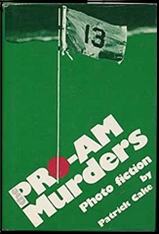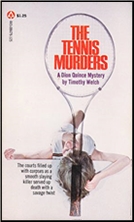Tue 21 Apr 2020
A PI Mystery Review by David Vineyard: TIMOTHY WELCH – The Pro-Am Murders.
Posted by Steve under ReviewsNo Comments
TIMOTHY WELCH – The Pro-Am Murders. Dion Quince #2. First published by Proteus, hardcover/paperback, 1979, as by Patrick Cake. Released for Kindle under the author’s true name, 2009.

Shortly after that quote appears in a Pentagon press release, a school bus full of the well-to-do children of a wealthy Monterey community is engulfed in a cloud of gas, and everyone on board is evaporated. That’s the act of terrorism that brings in professional writer/photographer Dion Quince (his books were a hybrid non-fiction form which he called “photo/prose,” and which artfully interwove poignant and joyous photographs with journalistic text of a high order), who in reality is the chief operative for Univest, Incorporated, the worlds most private private detective agency for whom Quince is both operative, bounty hunter, and killer when need be (reliable “terminators,” his boss calls them).
In his first adventure Quince managed to complete his assignment by getting in to Wimbledon as a player (The Tennis Murders, paperback original, 1976). Here Edmund Groom, head of the “non-existent J Section,†which is headquartered on the super secret freighter Poppa Maru, and his despised underling Dearlove, assign Quince (“Quince, my boy, it is always a pleasure to see and talk with you. You lack obsequiousness.â€) to investigate the missing children, but he thinks it is nothing but a kidnapping and not his kind of case.
Before going further it should be pointed out that the model for Quince and the two adventures he appears in is Trevanian’s existentialist art professor assassin Jonathan Hemlock from The Eiger Sanction and The Loo Sanction. Like Hemlock, Quince is cynical, self contained, a psychologically flawed superman, cold, and an egoist. During torture in Vietnam something happened to him and pain, rather than crippling him, energizes him, and he is left with a psychological kink worthy of the Shadow or the Spider in the pulps:
In short, he is ruthless, self reliant, and not to be trifled with.
It’s that and the well realized settings of the two Quince books that set them aside from the usual run of thrillers. Quince is easily as opinionated on just about everything as John D. MacDonald’s Travis McGee, and Welch’s tone and voice offer the perfect cool but cruel elegance of Quince’s icy world. Better still Welch does this sort of thing damn near was well as Trevanian himself, which is reason enough to meet Dion Quince and add him to your book shelves.
To actually imitate a writer like Trevanian you have to be almost as brilliant, cynical, opinionated, and erudite.
Like Hemlock, who took on assassinations to pay for his art collection, Quince has his elegant lifestyle in his converted winery home, Skyline, where he lives with his houseman Kato, to pay for, so there isn’t much question when the money is right he will be drawn into the case of the vaporized children plus his own sense of justice when he learns they are dead.

The other key factor in the series is the use of sports settings for the criminal and international goings on, Wimbledon in the first one, and in The Pro-Am Murders, the Bing Crosby Pebble Beach Golf Tournament where Quince, supposedly gathering material for his next book, is really after the man behind the brutal murder of twenty four seventh grade school children, a killer who signs his work Omnipotent, and likes to advertise.
There is some actual detective work to be done, Omnipotent, and his motive, to be uncovered, well done scenes of the celebrity golf tournament (James Garner has a nice bit) that you can enjoy whether you care for golf or not, and a fair share of suspense, action, sex, and luxury along the way most of it kinky though far from pornographic.
It is, like Trevanian’s own books, high level nonsense. Better written than most, the two books present an attractive and nuanced hero/anti-hero, a deeply wounded and damaged protagonist who features in two very entertaining adventures.
The Tennis Murders was a paperback original. The Pro-Am Murders was published by Proteus Press in a limited edition replete with grainy photographs that are supposed to be Quince’s work. Both books were written by Timothy Welch, who wrote at least four novels and one non-fiction book. I wish he had written more about Dion Quince. The two books are not enough.
Copies of The Tennis Murders can be found from various sellers at reasonable prices, and there is a E-book edition of The Pro Am Murders replete with the original photographs for under $2.00 on Kindle.
—
Editorial Comment: Both David and I have been wondering how it happened that the first book was apparently written under his own name, and he used a false one for the second. In fact it seemed a possibility that the pen name and his real name have been switched around all these years; that is to say Cake was real and Welch was the pen name. Some online searching came up with this obituary for Tim Welch, however, and the details seem to fit the stories he told, so this has ended that particular bit of speculation, at least for now.